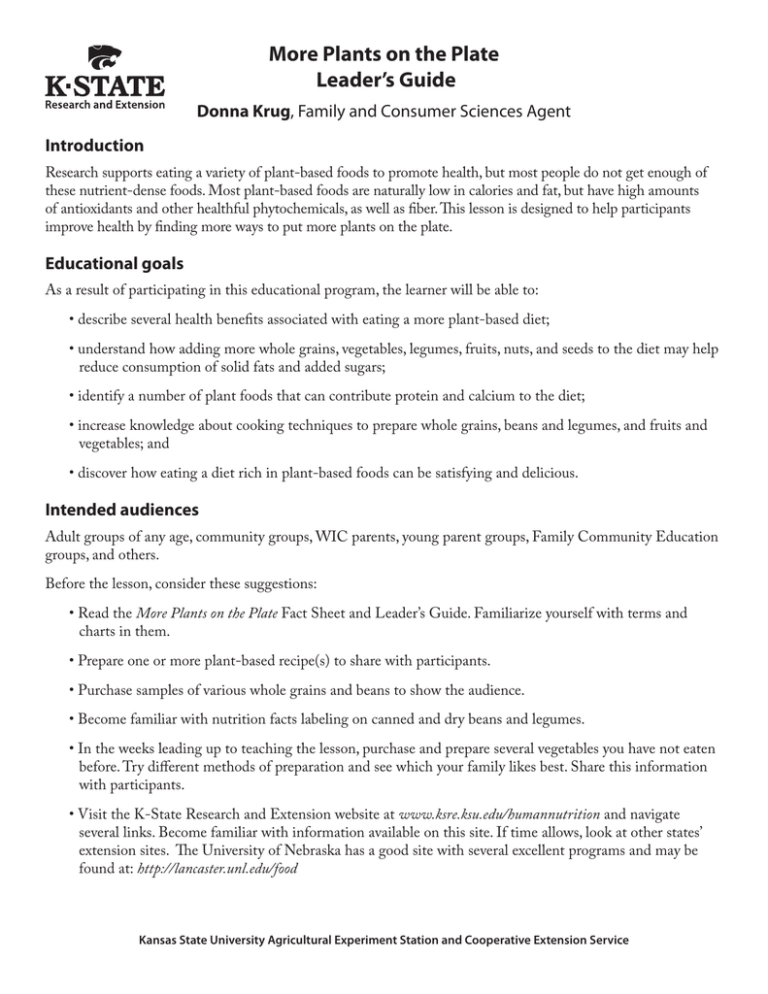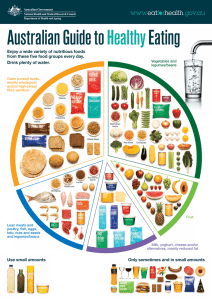
More Plants on the Plate
Leader’s Guide
Donna Krug, Family and Consumer Sciences Agent
Introduction
Research supports eating a variety of plant-based foods to promote health, but most people do not get enough of
these nutrient-dense foods. Most plant-based foods are naturally low in calories and fat, but have high amounts
of antioxidants and other healthful phytochemicals, as well as fiber. This lesson is designed to help participants
improve health by finding more ways to put more plants on the plate.
Educational goals
As a result of participating in this educational program, the learner will be able to:
• describe several health benefits associated with eating a more plant-based diet;
• understand how adding more whole grains, vegetables, legumes, fruits, nuts, and seeds to the diet may help
reduce consumption of solid fats and added sugars;
• identify a number of plant foods that can contribute protein and calcium to the diet;
• increase knowledge about cooking techniques to prepare whole grains, beans and legumes, and fruits and
vegetables; and
• discover how eating a diet rich in plant-based foods can be satisfying and delicious.
Intended audiences
Adult groups of any age, community groups, WIC parents, young parent groups, Family Community Education
groups, and others.
Before the lesson, consider these suggestions:
• Read the More Plants on the Plate Fact Sheet and Leader’s Guide. Familiarize yourself with terms and
charts in them.
• Prepare one or more plant-based recipe(s) to share with participants.
• Purchase samples of various whole grains and beans to show the audience.
• Become familiar with nutrition facts labeling on canned and dry beans and legumes.
• In the weeks leading up to teaching the lesson, purchase and prepare several vegetables you have not eaten
before. Try different methods of preparation and see which your family likes best. Share this information
with participants.
• Visit the K-State Research and Extension website at www.ksre.ksu.edu/humannutrition and navigate
several links. Become familiar with information available on this site. If time allows, look at other states’
extension sites. The University of Nebraska has a good site with several excellent programs and may be
found at: http://lancaster.unl.edu/food
Kansas State University Agricultural Experiment Station and Cooperative Extension Service
Presenting the lesson
Health benefits are gained when people increase their intake of whole grains, vegetables and fruits, and nuts and
seeds, while limiting the amount of saturated fat, added sugars, and highly processed foods.
Since many people may have questions about eating a more plant-based diet, review the questions and answers in
the participant’s fact sheet. Information here may help answer questions about the amount of calcium and protein
recommended for adults.
How much calcium do we need?
The recommended level of calcium for adults ages 19
through 50 is 1,000 mg per day. An intake of 1,200 mg per
day is recommended for women ages 51 and older and for
men ages 70 and older.
Calcium content of selected plant-based foods:
Food
Serving size
Amount of
calcium
Blackstrap molasses
2 tablespoons
400 mg
Collard greens, cooked
1 cup
357 mg
How many grams of protein do we need?
Calcium-fortified orange juice
8 ounces
300 mg
Most people living in the United States get more
than enough protein daily. Based on nutrition surveys,
Americans eat about 75 grams per day on average.
According to the Institute of Medicine, recommended
protein intakes range from about 40 to 70 grams each day,
depending on gender, age, body weight, and activity level.
Soy or rice milk, commercial
8 ounces
200 to 300 mg
Kale, cooked
1 cup
179 mg
Bok choy, cooked
1 cup
158 mg
Tahini
2 tablespoons
128 mg
Aren’t beans considered an incomplete source of protein?
Beans are sometimes referred to as an incomplete protein because they do not provide one of the essential amino
acids needed to build protein in the body. In reality, this is not a concern. Grains (which lack a different essential
amino acid) provide the amino acid missing from dry beans, and vice versa. Together, they complement each
other. Examples of common complementary proteins include beans and rice, a bean burrito (beans in a tortilla),
and beans and corn. Complementary sources of protein should be consumed over the course of a day, but not
necessarily at the same meal.
Are lentils as nutritious as dried beans, such as kidney, black, or garbanzo beans?
Absolutely! Like all dried beans and peas, lentils are high in fiber. Just ½ cup of cooked lentils provides nearly
as much fiber as 2 cups of cooked oatmeal, and much of it is soluble fiber, which helps lower blood cholesterol.
Cooked dry beans and lentils are low in fat and high in protein, dietary fiber, B vitamins (such as niacin,
thiamin, folate, and B6), and minerals (such as iron, zinc, magnesium, potassium, and selenium). Lentils are the
highest in folate of all legumes. Folate is important for producing and maintaining healthy DNA. Like other
legumes, lentils provide protein and antioxidant phytochemicals, such as flavonoids. Lentils are easy to prepare
since they don’t require soaking and can go from pantry to table in about half an hour. Red lentils take less time
to cook and become puree-like, so they are great for thickening soups. Green and brown lentils hold their shape.
Use them in salads, soups, or entrees.
Affordability of eating a healthy diet
Common complaints are: “I can’t afford to eat lots of fruits and vegetables,” or “Healthy foods are expensive.”
While people argue that the cost of fresh produce and grain products is high, it depends on perspective. A cup
of coffee or 20-ounce soda and a pastry can cost $6 or $7. In contrast, a container of pre-washed organic salad
greens and a 2-pound package of brown rice would cost about the same amount, but the salad and rice can be
consumed over several days by several people.
Practical aspects of eating a healthy diet
Encourage your audience to choose nutrient rich foods at every meal and at snack time. Nutrient-rich foods
provide substantial amounts of vitamins and minerals in relationship to the number of calories and the amount
of added sugars and fats. Nutrition experts agree that most Americans are overweight, yet undernourished:
People consume too many foods that are high in calories but low in nutrient value. As the nation turns its
attention to reducing calories, getting the most nutrients from those calories becomes essential.
A simple chart to help make a person’s transition to a healthier diet realistic
(Note to leaders: This would be a good place to share nutrition facts labels from some of the food choices,
looking at ingredients as well as fiber, fat, and sugar content.)
Eat MORE often
Brown rice
Stone-ground 100% whole-wheat bread
Rolled oats
Whole fruits
Baked sweet potato
Whole grain flour tortillas
Legumes: lentils, peas and beans
Eat LESS often
White rice
Enriched white bread
Refined grains and sugary cereals
Fruit juice
French fries
White flour tortillas
Highly processed snack foods
What can be done if someone craves a pastry or french fries every day? Think about what is really being craved.
Perhaps it is the texture or the saltiness of the fries. Try roasting thin wedges of a sweet potato, tossed with
a little extra virgin olive oil, and spiced up with a little garlic powder and sea salt. All you need is the right
ingredients, a few foolproof recipes, and a desire to eat wholesome food.
Before people can change their way of eating, they must change their way of thinking. Be adventurous and
open-minded. With a diet rich in plant foods, there is no such thing as typical. Consider a sample menu suitable
for a cool fall evening: grain-stuffed butternut squash, steamed kale, coleslaw, and baked apples with walnuts.
Part of the joy of eating is discovering new things that you love — new flavors you have never tasted and
mouthwatering new dishes and meals you can make for yourself and family.
Conclusion
It is not easy to change eating habits. But gradually, as more vegetables, fruits, grains, and legumes are added to
your daily menu, you will discover or rediscover how “real food” looks, smells, and tastes. Reconnect with what
you eat and savor each bite for all of the benefits you gain from eating whole food.
Answers to the pre/post test:
1. T
7. F
2. F
8. T
3. F
9. F
4. F
10. T
5. T
11. T
6. T
12. T
Resources
Institute of Medicine, 2005, Dietary Reference Intakes for Energy, Carbohydrate, Fiber, Fat, Fatty Acids, Cholesterol, Protein, and Amino
Acids (Macronutrients). Washington, DC: National Academy Press.
Institute of Medicine, 2011. Dietary Reference Intakes for Calcium and Vitamin D. Washington, DC: National Academy Press.
Duyff, Roberta Larson, MS. RD, FADA, CFCS, 2006. American Dietetic Association Complete Food and Nutrition Guide, 3rd edition,
pages 226-227, 241-242, 505-522. Hoboken, NJ: Wiley.
USDA, 2005. Composition of Foods, Nutrient Data base for standard reference, http://www.ars.usda.gov/main/site_main.
htm?modecode=12-35-45-00.
Pre-test and post-test for participants
Leaders: Make two copies of these questions, circling pre-test on one and post-test on the other, staple together, and
number. Give to participants as they arrive.
T
F
1. S ome dark green vegetables are a good source of calcium.
2. Beans must be eaten with rice in the same meal to make the protein in them complete.
3. Q
uinoa is a fruit grown in the Middle East.
4. E ating lots of complex carbohydrates is one reason for the rise in obesity rates in our country.
5. B
rown rice, millet, barley, popcorn, and oatmeal are all examples of whole grains.
6. There are virtually no nutrients in animal-based foods that are not adequately provided
by plants.
7. A
juicy steak has more fiber than a serving of popcorn.
8. N
uts and seeds are good sources of protein.
9. L entils must be soaked before cooking for best results.
10. M
ost plant-based foods are naturally low in calories and fat.
11. A
nutrient-rich food has lots of vitamins and minerals compared to the number of calories
it provides.
12. A
person with a chronic disease could alleviate symptoms by eating more plant-based foods
and fewer fats, sugars, and refined grains.
Brand names appearing in this publication are for product identification purposes only. No endorsement is intended,
nor is criticism implied of similar products not mentioned.
Publications from Kansas State University are available at: www.ksre.ksu.edu
Publications are reviewed or revised annually by appropriate faculty to reflect current research and practice.
Date shown is that of publication or last revision. Contents of this publication may be freely reproduced for educational purposes.
All other rights reserved. In each case, credit Donna Krug, More Plants on the Plate, Leader’s Guide,
Kansas State University, July 2011.
Kansas State University Agricultural Experiment Station and Cooperative Extension Service
MF2978
July 2011
K-State Research and Extension is an equal opportunity provider and employer. Issued in furtherance of Cooperative Extension Work, Acts of May 8 and June 30, 1914,
as amended. Kansas State University, County Extension Councils, Extension Districts, and United States Department of Agriculture Cooperating, Gary Pierzynski, Interim
Director.







